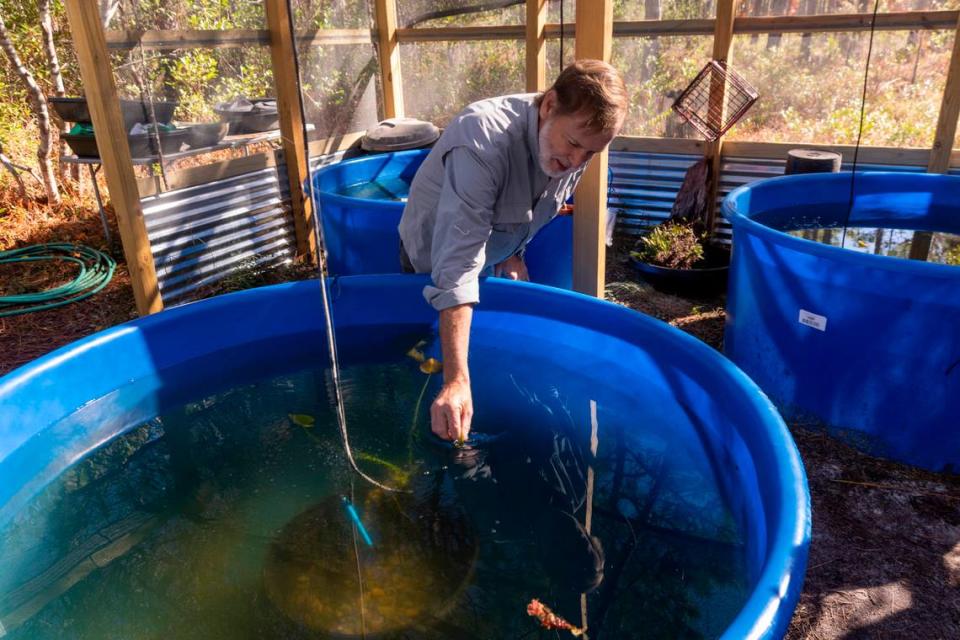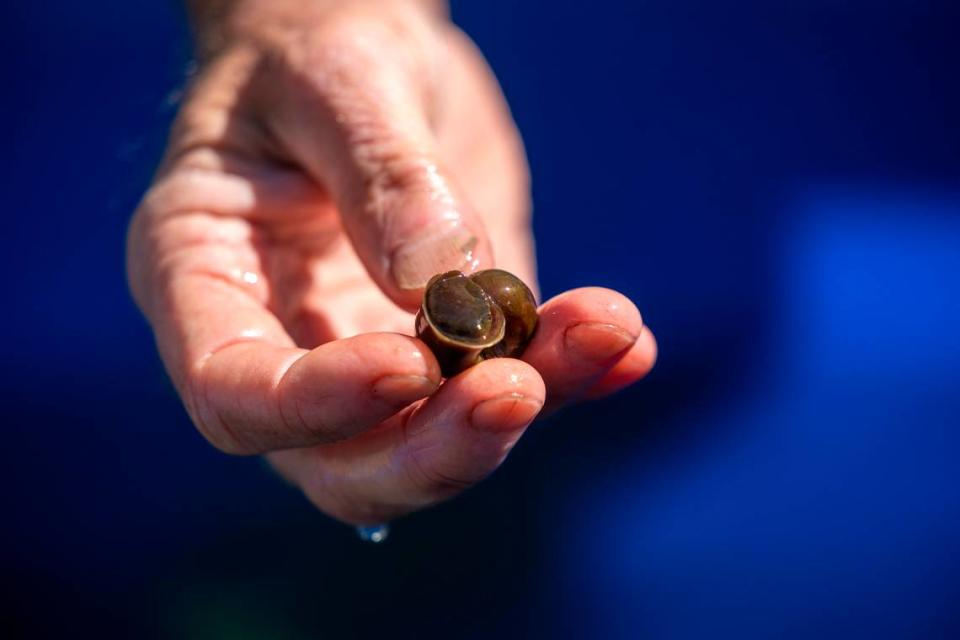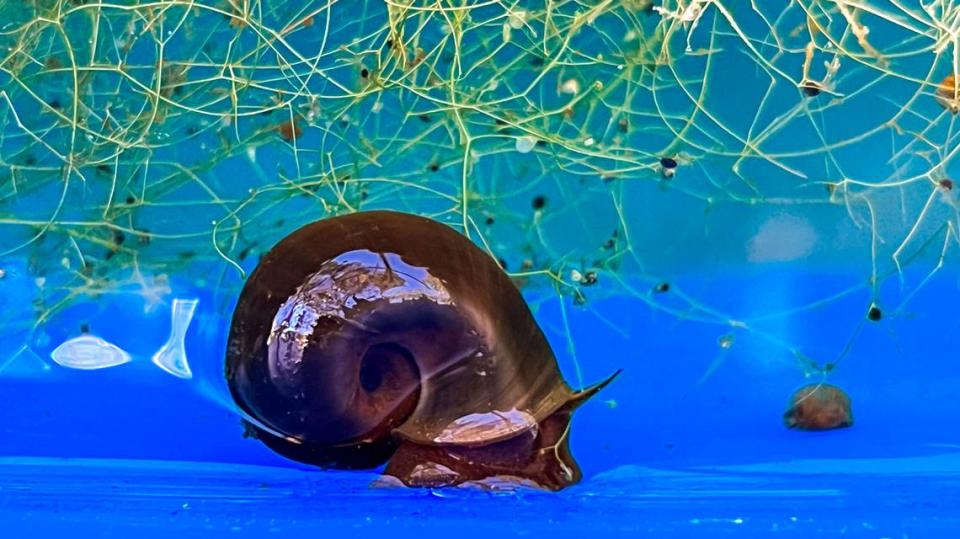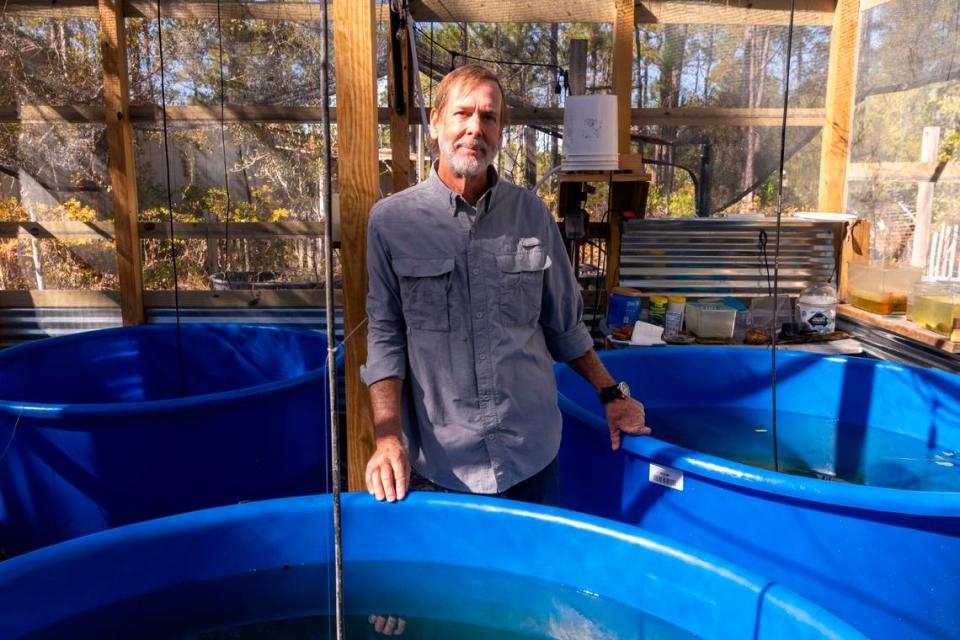A near-extinct NC snail is back in the wild. Its savior still sees too many threats.
A small shed-like structure built in the longleaf pine forest a stone’s throw from Andy Wood’s Hampstead home is one of the last places on Earth that the magnificent ramshorn snail can be found.
For more than 30 years, Wood has protected the species, which is only found in the Lower Cape Fear River basin, by creating a habitat that is growing increasingly rare. He’s installed freshwater tanks and filled them with spatterdock water lilies while diligently keeping frogs, turtles and other predators away.
Over time, that’s evolved into what Wood calls “snail central,” a wood-framed structure with sliding doors that contains five large blue plastic tanks. Numerous other tanks sit outside, many covered in black mesh as Wood works to transfer snails from them and into the indoor tanks.
By encouraging people to think about this small snail, Wood hopes to raise awareness of broader conservation needs and of how human activity is threatening the region.
“Yeah, this is a story about snails, but the bigger story is about the Cape Fear River and what we’ve done to it and its adjacent bottomland hardwood swamps. Those swamps have been decimated and altered and damaged by saltwater intrusion,” Wood said.

Wood’s work is paying off. The N.C .Wildlife Resources Commission now manages its own captive population at its Conservation Aquaculture Center in Marion and N.C. State University manages another population. Recently, the Wildlife Resources Commission started reintroducing snails to the wild for the first time in decades, a step biologists and advocates hope will play a pivotal role in the species’ recovery.
The reintroduction is a bright spot in a conservation field often marked by gloom, Emilia Omerberg, the Wildlife Resources Commission biologist who works with the snail, told The News & Observer.
“This has been really exciting for a lot of people to see potential for success and the excitement of being able to take the first steps in the process of successfully recovering this species,” Omerberg said.
Reintroduction is crucial to the species’ long-term survival, Will Harlan, the southeast director and senior scientist for the Center for Biological Diversity, said.
“We need to get them into the wild. We need to get them reproducing in the wild and have large populations establish strongholds so that these captive breeding facilities are essentially the last step and not the lifeline that they are right now,” said Harlan, who has long lobbied the U.S. Fish and Wildlife Service for additional protections for the snail.
Earlier this year, the Fish and Wildlife Service formally determined that the snail is an endangered species and designated critical habitat for it. The agency has prepared a recovery outline and expects a full plan to be available within 18 months.

Rescuing ramshorn
Even at its peak, experts believe magnificent ramshorn had a small range along the Cape Fear River.
Biologists like Wood think it lived in beaver ponds, which were largely wiped out in the early 20th century. The four places the snail has been spotted in the wild — Greenfield Lake in Wilmington and three Brunswick County ponds — were formed by old mill dams.
For a time in the mid-1900s, biologists believed there was a chance the snail was extinct. But a 1970s article in the book “Threatened and Endangered Species in North Carolina” noted that the snail could still be living in some small refuges like Orton Pond, near the Cape Fear River.
Bill Adams, who was a U.S. Army Corps of Engineers biologist, had a chance to sample the pond for salinity around 1987 and decided to look for the snail.
Within 10 minutes of first dipping his net in the water, Adams pulled a snail out.
“I started poking around and sure enough, there it was,” Adams, who is now a pastor in Greensboro, told The N&O.
Adams contacted the Smithsonian to say the snail was still alive and submitted pictures and an article about his findings to the Nautilus, a New York-based science magazine.
Soon after, he reached out to Wood.
“The history of these mill ponds was when a good hurricane comes through and drops 20 inches of rain and blows the dam out, who knows what you’ve got. So I wanted to get at least one population that was sustainable, that I could guarantee was there,” Adams said.
Adams and Wood spent much of the summer of 1992 looking for snails that could be brought into captivity. They searched every pond they could gain access to, dipping their nets in and checking slow-moving areas. They spent the most time looking around the spatterdock water lilies where the snails like to lay their eggs.
Finally, on a blistering hot August day, they found 37 snails on a Brunswick County pond. Wood took them to the N.C. Aquarium at Fort Fisher, where he worked, and those snails are where the rescue of the species began.
It was lucky that they did.
Days after Hurricane Fran Struck in 1996, that pond’s owner called Wood to say the dam had blown out and saltwater was washing in with every high tide.
“Snails were immediately wiped out of that pond, and I sampled in there multiple years and multiple times and haven’t found them since,” Wood said.

A ‘charismatic’ snail
The magnificent ramshorn is a lunged snail that has only been found in the Lower Cape Fear River basin. Its defining features include a shell that spirals on both sides and often features leopard-print spots.
The snail lives for about two or three years, and when fully grown its shell is about 1.5 inches wide and an inch tall.
Wood views the snails and other small species like it as rivets in the ecosystem. Without protecting those smaller creatures, he warns, the larger species that depend on them will face significantly more peril.
Snails like the magnificent ramshorn eat plant matter in water, digesting it and then pooping it out, Wood said. Their refuse is then available for plankton, which feed small fishes and gradually work their way up the aquatic food pyramid, all the way to large-mouth bass.
“If you don’t start at the bottom, we have no hope of protecting what’s at the top,” Wood said.
Everyone who works with magnificent ramshorn seems to have a favorite fact or feature.
For Omerberg, it’s the shell and features the snail exhibits when it pokes out of the opening.
“It’s really kind of charismatic-looking. It’s got almost facial features, and it’s quite magnificent,” Omerberg said.
For Adams, it’s that the snail actually goes blind as it grows older.
“Why anything would ever just go blind as part of its natural history is really pretty bizarre,” Adams said.
Bringing the snail into captivity has helped researchers understand the threats it faces.
Before 1992, the snail had been seen, but nobody had spent time observing it. Wood quickly realized just how vulnerable it is to salt.
He put the snails in a tank at the Fort Fisher Aquarium, perched near the Atlantic Ocean. A week later, Wood checked on them only to find the snails drawn within their shells at the bottom.
“I instantly had one of those (light-bulb) moments,” Wood said.
He realized that the salty air at Fort Fisher was affecting the fresh water and that the snails were dramatically susceptible to its presence.
Wood took the snails to his then-home in Wilmington and commandeered a blue wading pool that belonged to his sons, who were then 3 and 5 years old.
“I said, ‘Sorry, guys, this is now for snails.’ That was the first snail tank. It’s just graduated over time,” Wood said.
Safe Harbor Agreement and Wildlife Resources
The magnificent ramshorn is one of 21 endangered or threatened aquatic species the N.C. Wildlife Resources Commission is working to reintroduce using a safe harbor agreement with the Fish and Wildlife Service.
Rachael Hoch, the Wildlife Resources Commission’s assistant chief of inland fisheries, likens reintroducing species to the wild to placing eggs in more baskets.
“If something catastrophic happened, like a hurricane wiped out the habitat and that was the only place that you could find the species, you don’t have redundancy. So by having more populations on the landscape, those species have a greater potential to exist and thrive,” Hoch said.
In the case of the magnificent ramshorn, reintroduction first meant finding a pond that has slow-moving or still water, a neutral pH level and no salt. That’s a tough ask in Southeastern North Carolina.
“Ramshorn is difficult because it faces a lot of challenges being so coastal and having the saltwater intrusion coming in,” Hoch said, adding that the snail lives dangerously close to salty areas for a species that is so intolerant to those environments.
Omerberg has been tasked with finding those ponds and then monitoring the snails.
The first reintroduction happened in October, when about 800 snails were placed in a Brunswick County pond on private property. That pond is within the snail’s historical range, but is not one of the places where snails were found previously.
To prepare the pond, Omerberg and Wildlife Resources Commission staff put agricultural lime in the water to help keep its pH levels neutral and planted native aquatic vegetation for the snails to eat.
Omerberg checks on the snails by donning a wet suit and diving, carefully pulling herself along the bottom by her fingertips to avoid crushing the tiny creatures. She searches for snails and eggs, noting where they’re located and how they’re acting.
“It’s been a long time since they’ve had free reign of a natural environment, so we’re just learning a lot right now about what they do given all of the options,” Omerberg said.
They’re doing well enough that the commission recently put 2,000 more snails in the pond. The next hurdle will be how they handle the winter months, as the snails go dormant when the water grows cold.
“Depending on survival numbers and reproduction success in the spring, then I think we’d start discussing further introductions,” Omerberg said.
Aided by the Safe Harbor agreement, Omerberg is looking for more ponds where the snail can be reintroduced. Under that agreement, private landowners agree to work with the Wildlife Resources Commission to make their property available for the reintroduction of threatened and endangered species.
Wildlife officials see it as a key tool in a state where much of the land is privately owned.
“We have to do this together in order to actually conserve species in their habitat,” Hoch said.
The end goal, Hoch added, is to reintroduce the species to their native habitats and recover them to a point where monitoring and conservation efforts aren’t needed.

Threats to ramshorn
Wood is worried that even if they’re reintroduced to the historic areas where they lived, the magnificent ramshorn will face the same threats anew. And, he notes, those challenges threaten other species and even pose some challenges to humans in the Lower Cape Fear area.
For example, the magnificent ramshorn is tremendously sensitive to changes in water quality and to the saltwater intrusion caused by climate change.
As sea levels continue to rise, saltwater will spill onto more land and push further up the creeks that feed into and swamplands bordering the Cape Fear River. Bleached cypress trees are a sentinel of this intrusion throughout the region.
And, the Fish and Wildlife endangered species notice adds, higher temperatures and longer periods between rains will likely lead to more demand for and stress on the freshwater that magnificent ramshorn need to survive.
For now, the Fish and Wildlife Service has identified Orton Pond and Big Pond as critical habitats for the snail, water bodies that total 739 acres. Adam and Wood have found magnificent ramshorn in both ponds.
The agency could also introduce the species to two other ponds within its historical range as part of its recovery, according to the listing.
Advocates worry those habitats aren’t enough.
“They’re simply not safe for the survival of an entire species. We can’t pin this species’ survival to two privately owned ponds in the floodplain near the Cape Fear River, which is already experiencing serious saltwater intrusion,” said Harlan of the Center for Biological Diversity.
That organization has urged the FWS to identify five more critical habitat sites either farther upriver in the Cape Fear watershed or in the adjacent Waccamaw River watershed.
For now, the Wildlife Resources Commission’s reintroduction efforts are focused on the places where the snail has been found historically.
But, Hoch said, the magnificent ramshorn “was lost from that area. With rising sea level, if we as a resource agency don’t think about assisted migration, getting it outside of its historical range, we could lose the species from the planet.”
Still, Hoch said, deciding to put the species in a new place would mean not only considering whether the habitat is viable for magnificent ramshorn, but also whether its introduction would have any impact on the species already living there.
Wood is also worried about the Port of Wilmington’s proposed deepening of its shipping channel from 42 to 47 feet to let bigger ships containing more containers travel up the Cape Fear River.
That project would allow more saltwater to flow upstream, Wood warns, threatening key habitats, including those that could be used by magnificent ramshorn. For a species whose entire historical range amounts to freshwater ponds in the flat swamplands around the Cape Fear River, more saltwater poses a dramatic threat.
As a solution, Wood wants any approval of the dredging to include large swaths of protected land upstream of the Cape Fear River’s Lock and Dam Number One. That would protect the snails and other species from salt while potentially offering similar habitat to the places where they historically lived.
“I’m hoping that the snail as a flagship will raise awareness of the importance of the littler things around us. And is that enough to warrant all of this?” Wood said, raising his hands among the tanks and sanctuary he has built and maintained over decades. “Yeah, I think so.”
This story was produced with financial support from the Hartfield Foundation and 1Earth Fund, in partnership with Journalism Funding Partners, as part of an independent journalism fellowship program. The N&O maintains full editorial control of the work.

